2016
Previous Photo Albums
The goal of this page is to allow Grand Island residents and others to see the essence of Grand Island.
E-mail
Let's show the world what a beautiful place Grand Island really is.
Mary Stewart - December 2016
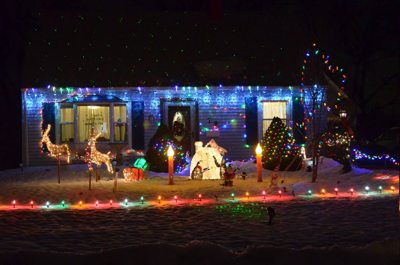



Our wonderful photographer Mary Stewart took these photos in her Kaegebein neighborhood this week. Happy holidays!!!
Dick Crawford - October 2016
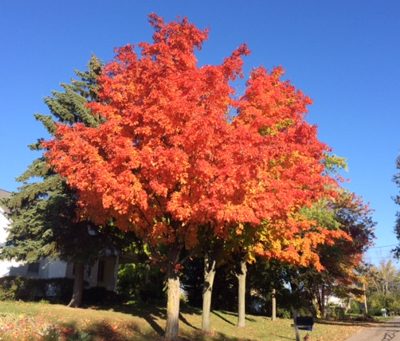 Dick Crawford recently took this picture on North Colony.
Dick Crawford recently took this picture on North Colony.Linda Rowe - August 2016
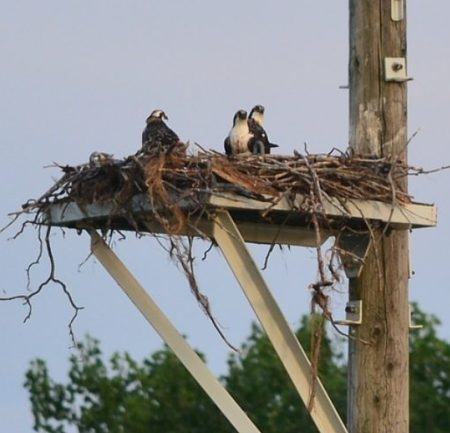
Osprey mom & babies.
Linda Rowe recently took this picture of an Osprey family at the Little Beaver Lagoon.Ever knowledgable Paul Leuchner provided background information regarding Ospreys at Beaver Island Park. He wrote: "Biologists at the New York State Department of Environmental Conservation, Region 9 Office in Buffalo, NY confirmed that the nesting platform in Beaver Island Park was used by a pair of Ospreys for the first time this year. Two offspring were produced. Once a tower like this one is used for nesting it will be occupied every year by the same pair of birds. The Osprey has a lifespan of up to 15 to 20 years and during that time individual birds may log more than 160,000 miles as they migrate back and forth between North America and South America.
Ospreys have a reversible rear toe that allows them to efficiently grasp prey with two toes in front and two behind. Whenever an Osprey is flying with a fish in its talons the fish will always be facing forward to minimize drag. Studies have shown that an Osprey iscapable of catching a fish once every 12 minutes. They can dive completely underwater and their eyes are protected by nictitating membranes that function like underwater goggles. The increase in population of Ospreys in the upper Niagara River can be attributed to the ample fish populations produced by all of the ongoing aquatic habitat and wetland restoration projects. Although Osprey populations are now stable they were nearly wiped out several decades ago by the rampant application of pesticides like DDT."
Thanks Linda & Paul!
Paul Leuchner - July 2016
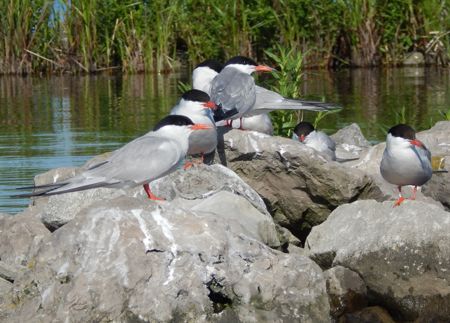
Group of Common Terns
Story and photos by Paul Leuchner.This photo of a group of Common Terns was taken during a kayak trip to Strawberry Island on June 18, 2016. The terns are a part of a much larger colony nesting on the partially completed habitat enhancement area at the northeast tip of the island. Up to four eggs are laid in a nest that is nothing more than a simple scrape in some sand or gravel. In New York State this species is listed as threated most likely because of competition with the ring-billed gull for nesting sites and human intrusion within prime habitat areas. Each year hundreds of terns are banded in an effort to track their movements and define migration patterns. If you look closely at the lone tern just to right of the group in the center of the photo you can see the actual leg band.
Paul Leuchner - June 2016
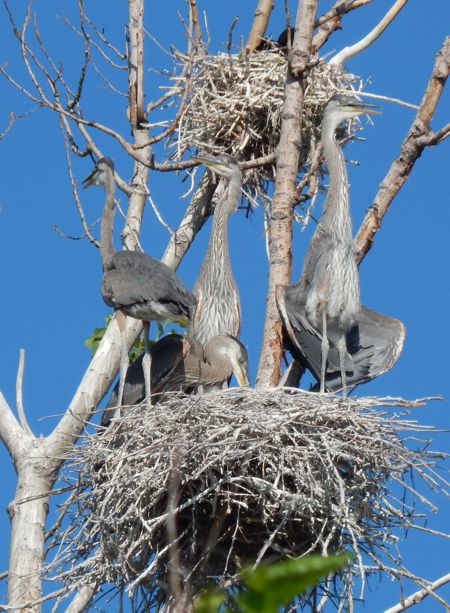
Great Blue Heron family on Motor Island.
Story and photos by Paul Leuchner.The colonial bird nesting season is well underway on Motor Island. Our Great Blue Heron chicks have grown quickly and most can now fly although the adolescents still prefer to stick close to their parents. The photo above shows two adolescent herons and their parents at the family nesting site on Motor Island. The island is the only heron rookery on the Niagara River and provides nesting habitat for the Great Blue Heron, Great Egret, Black Crowned Night Heron and the Little Green Heron as well as the Double Crested Cormorant. Nesting birds can be observed from the water but no one is permitted to land on the island.
Lately, there has been quite a bit of news about Motor Island and a new island close by referred to by the media as "Frog Island". Last year, in a feature Buffalo News article the reporter erroneously referred to the new island between Motor Island and Strawberry Island as Frog Island. This is historically incorrect. Frog Island and Motor Island are actually one in the same. The journals of early settlers and charts dating back to the early 1700's clearly show Frog Island at the same exact location as the present day Motor Island. The Frog Island name was subsequently confirmed in 1824 when James Tanner working on behalf of Simeon DeWitt the first Surveyor General of the State of New York officially surveyed the island. The Frog Island name persisted into the early 20th Century but in 1910 the island renamed Motor Island following development of yacht club on the island by the notorious Buffalo waterfront boss William J. "Fingy" Connors. Connor's yacht club soon became one of the premier boat racing centers in North America. By the 1980's the yacht club was gone and the island was largely abandoned except for an attempt by several locals to make it into campground. In 1989 the first Great Blue Heron nests were observed on the island and within a few years a large nesting colony was established. Recognizing the ecological importance of this island, the State of New York purchased the island in 1998 and establishing a Wildlife Management Area at that location. Since then the island has been under the protective stewardship of the New York State Department of Environmental Conservation.
What about the new island mistakenly referred to as Motor Island? Well, it was never an island at all. It was a shallow area that during low water periods would be exposed and appear to be like an island. When the high waters returned to the area it was submerged. At the present time the new island built on the original footprint of this shoal remains unnamed. Officials at the New York Power Authority (NYPA) working in cooperation with other environmental agencies and organizations will soon establish a name for the new artificial island as well as some of the others currently under construction closer to Strawberry Island. The NYPA is committed to naming the islands in a way that accurately reflects the historic and environmental context of the upper Niagara River.
Linda Rowe - June 2016
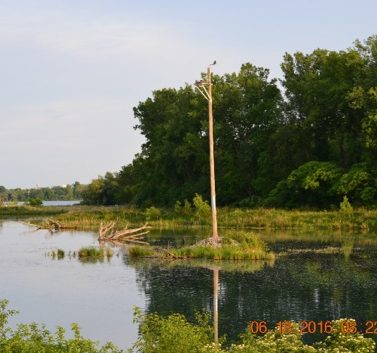
Osprey Nest in Beaver Island Lagoon.
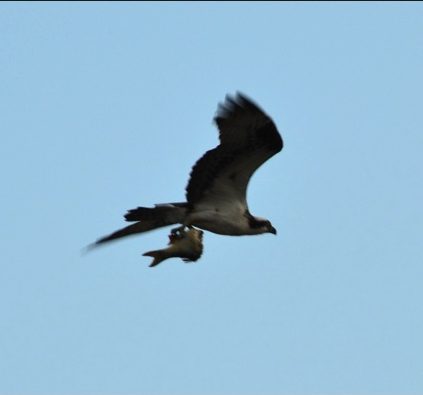
Osprey with fish in talons.
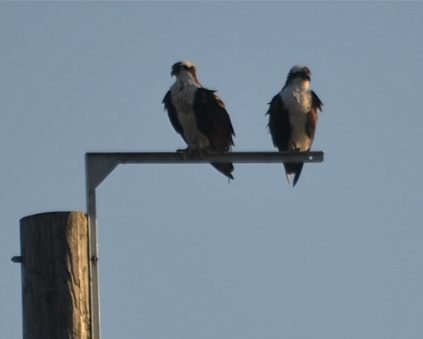
Osprey hanging out.
Linda Rowe and her husband often go to Beaver Island to see what the osprey are up to. The nesting platform is located in the Beaver Island Lagoon, directly in front of the entrance to the park.Paul Leuchner - June 2016
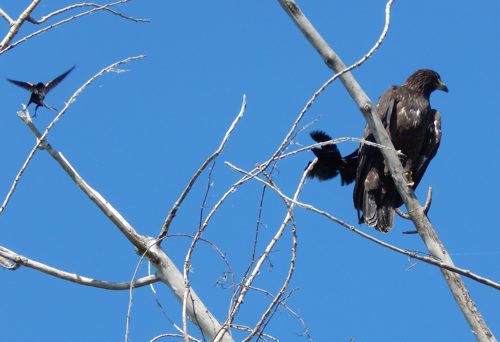
Immature bald eagle being harassed by red winged blackbirds.
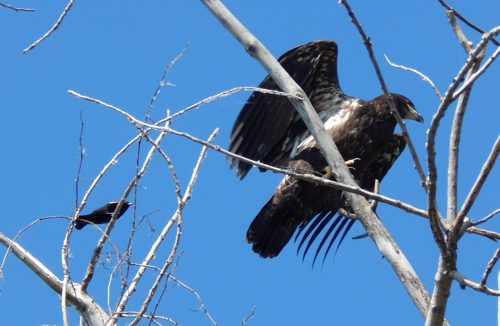
Eagle is flexing its wings in an effort to ward off the annoying birds.
Story and photos by Paul Leuchner.During an early morning kayak trip around Strawberry Island on June 18, 2016, Paul Leuchner came upon an immature Bald Eagle that was being harassed by a group of red winged blackbirds. The young eagle attempted to evade the pursuers by landing on the branch of a dead tree and fully extending its wings. The blackbirds pressed their attack until the eagle finally had enough and flew away.
The red winged blackbirds seen here were engaging in a form of avian behavior known as mobbing. The whole incident probably came about because the eagle had invaded their territory or got a little too close to an active nesting site. It takes four years for an eagle to develop its traditional adult plumage. The Bald Eagle is protected by Federal and State law and there are substantial penalties for interfering with their nesting and feeding sites. These photos were taken from the open waters of the Niagara River using a telephoto lens.
Mike Dudley - June 2016

Click photo for larger view.
Mike Dudley recently took this picture of the north Grand Island bridges from the Niagara Falls shoreline.Kim Ludwig - June 2016
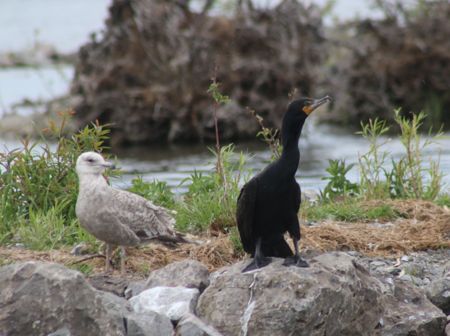
Gull and cormorant.
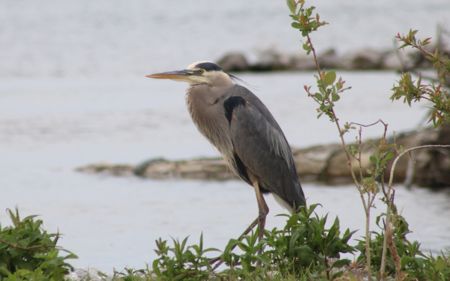
Great Blue Heron.
Kim Ludwig was boating with husband Michael on Wednesday, June 15th in the East River. She took the photos above at the newly constructed habitat enhancement project between Motor Island and Strawberry Island.
Dave Reilly - June 2016
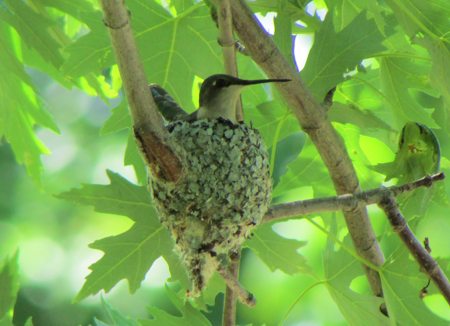
Dave Reilly recently took a picture of a nesting hummingbird.
Paul Leuchner - May 2016
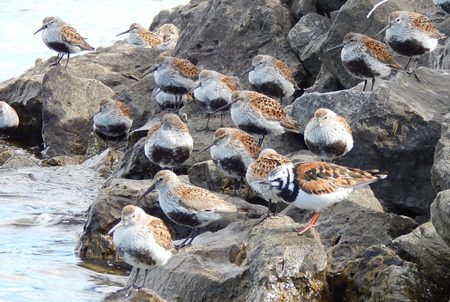
Migrating shorebirds resting on one of the outer islands in the East River Marsh at Beaver Island State Park. Most are Dunlins except for a single Ruddy Turnstone that can be seen lower right.
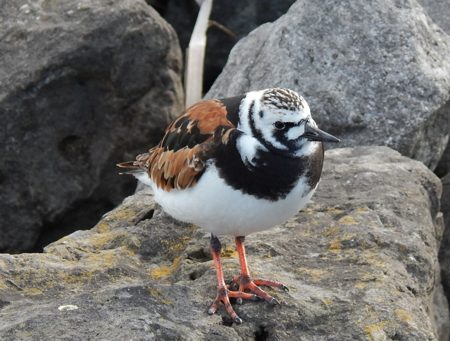
A close up of a Ruddy Turnstone at the East River Marsh.
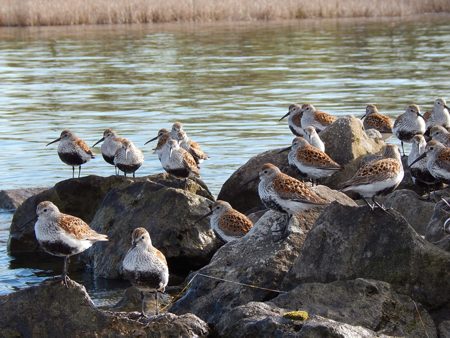
Roosting Dunlins gathering at the tip of one of the offshore islands protecting the East River Marsh.
Click photos for larger view.
Story and photos by Paul Leuchner.Coastal wetlands like those along the Niagara River have many important values. During the spring and fall migrations they serve as rest stops for flocks of birds passing through the region. The restored East River Marsh in Beaver Island State Park functions as a stopover for flocks of birds following the western edge of the Atlantic Flyway. When the spring migration is underway different species of shorebirds can often be observed on any given day. At this time of year the Ruddy Turnstone, a member of the Sandpiper family, is moving north to breeding areas in the tundra of northwestern Alaska. The migrating Dunlin also prefers arctic environment. The diverse and globally significant species of birds frequenting the Niagara River corridor is one of the reasons it has been designated by the National Audubon Society as an Important Bird Area of International Significance.
Paul Leuchner - May 2016
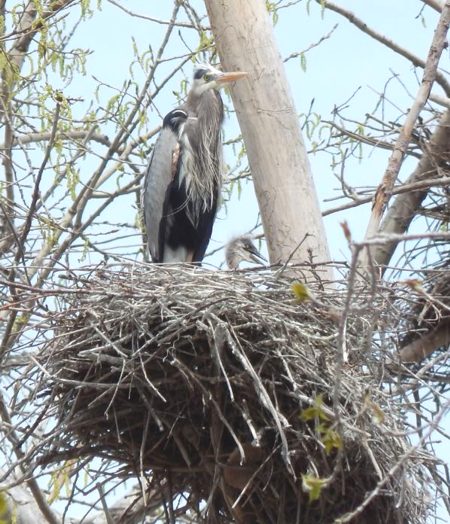
Great Blue Heron and chick at the rookery. Both parents feed their young by regurgitating partially digested fish.
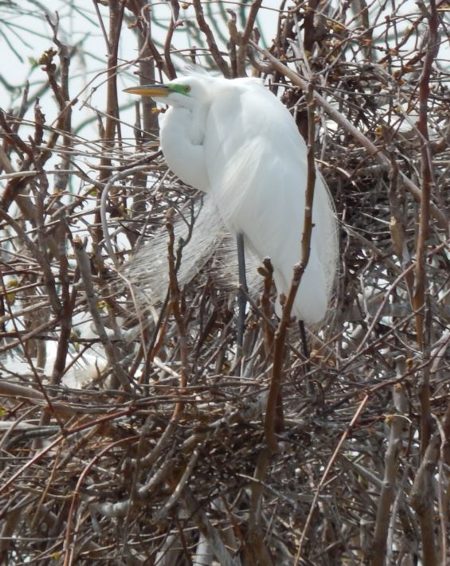
Great Egret exhibiting typical nesting plumage. A century ago fashion demand for these wispy feathers nearly led to the extinction of this species.
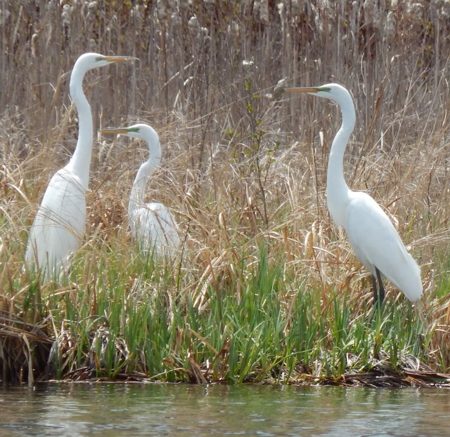
Great Egrets feeding in the shallows of the East River Marsh at Beaver Island State Park
Click photos for larger view.
Story and photos by Paul Leuchner.
Herons and egrets are a common sight around Grand Island these days. For most of the year individual birds lead a solitary existence but each spring they gather together in colonies called rookeries to complete the annual nesting cycle. A small island just offshore of Beaver Island State Park has been the home for nesting herons and egrets since the early 1990's. During the nesting season common island sights include the Great Blue Heron, Great Egret, Black Crowned Night Heron and Little Green Heron. Originally charted as Frog Island back in 1824 it was renamed Motor Island in 1910 and later became known as Pirates Island in the 1980's. The island was subsequently acquired by the State of New York and is now a designated Wildlife Management Area. Birds can be observed and photographed from the water but landing on the island at any time is strictly prohibited.
Ken Koch - May 2016
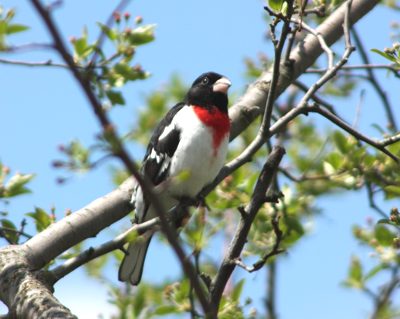
Ken Koch took this picture of an Rose Breasted Grosbeaks at his home on East River near Ransom on Tuesday, May 2nd
Ken Koch - April 2016
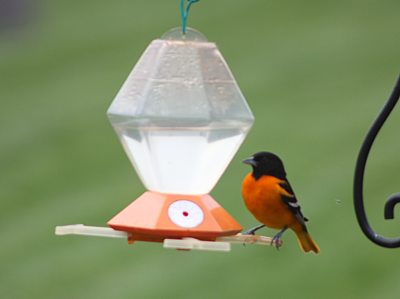
Ken Koch took this picture of an Oriole at his home on East River near Ransom on Monday, April 25th.
Paul Leuchner - March 2016
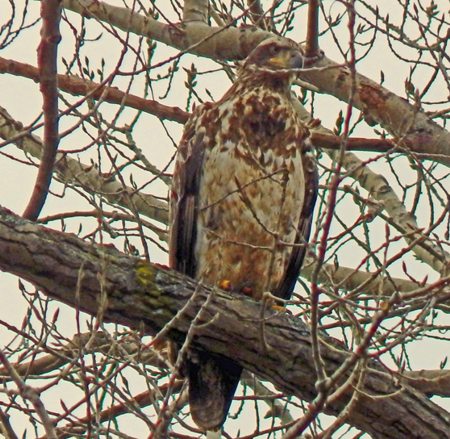
Click photo for larger view.
Paul Leuchner took this photo of an Immature Bald Eagle taking in the scenery at Beaver Island State Park during the afternoon of March 7th.Dick Crawford - February 2016
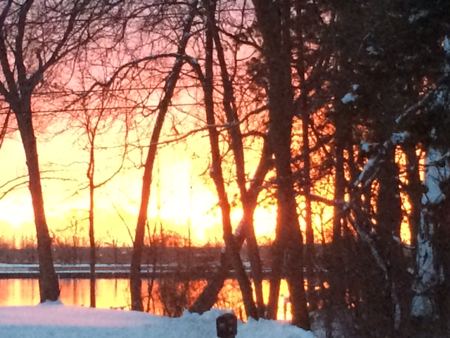
Dick Crawford snapped this photo looking at the sunrise on East River near North Colony Road on Friday, February 19th.
Luna & Garnet - February 2016
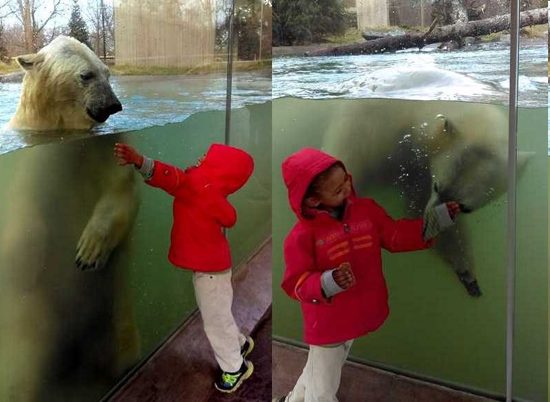
Four year-old GI resident Garnet found a friend at the Buffalo Zoo this week, Luna the polar bear.



